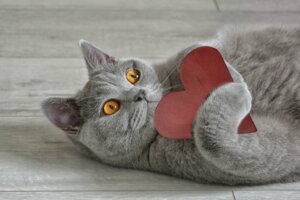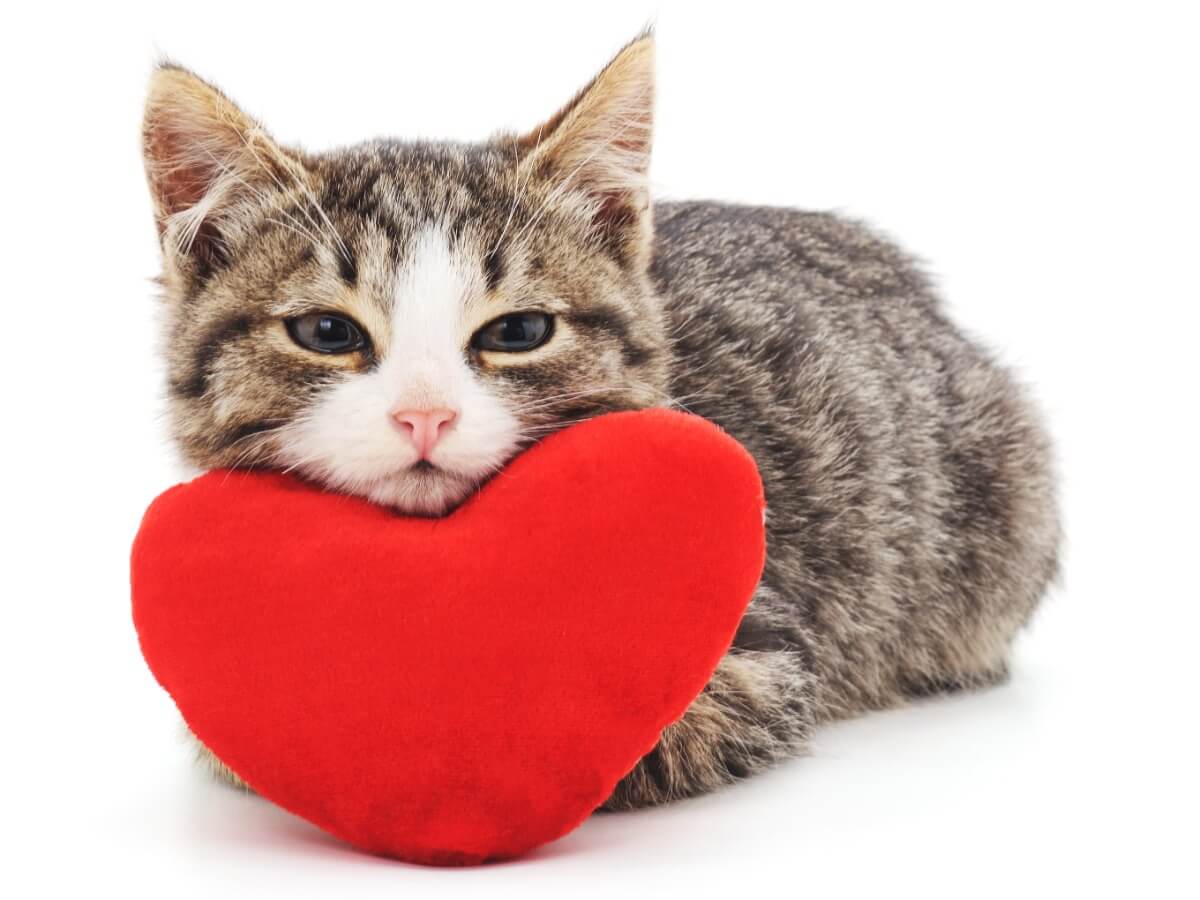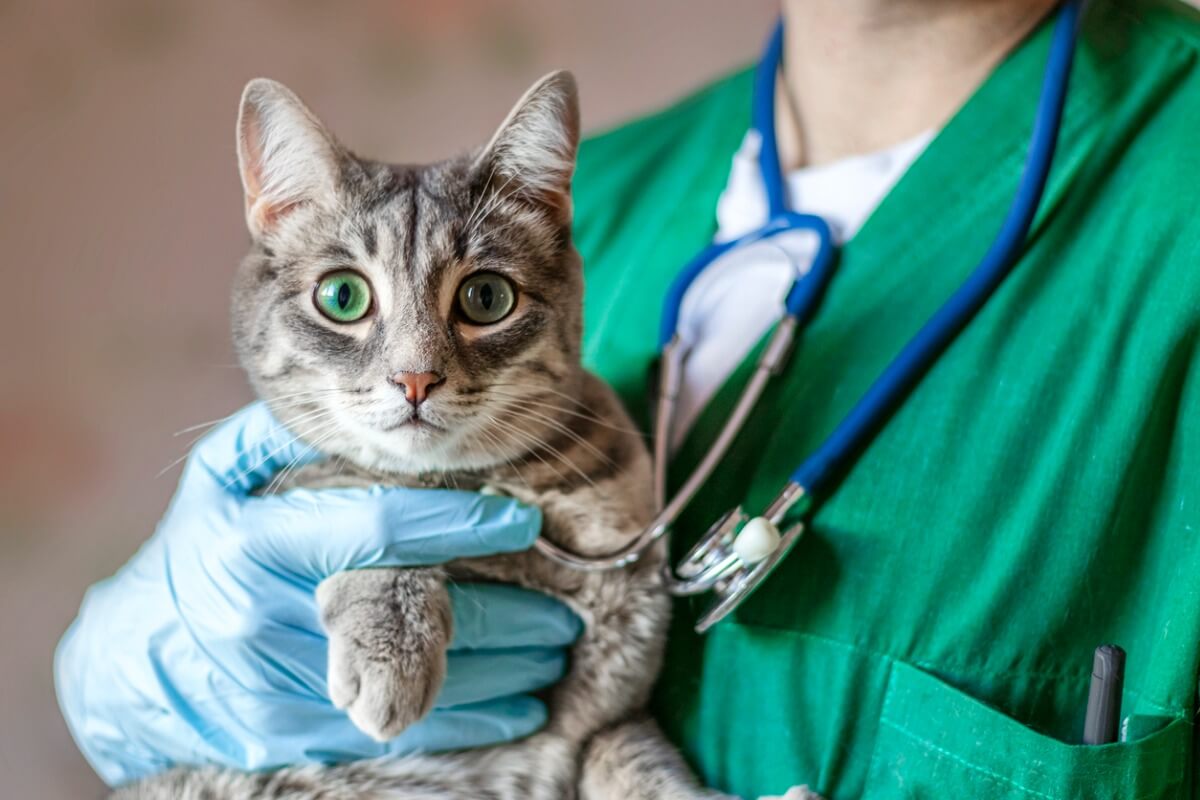Feline Hypertrophic Cardiomyopathy: Symptoms and Treatment

Diseases of the circulatory system are of the greatest concern to owners, as they’re usually chronic and can compromise the life and well-being of the animal. Of all of them, feline hypertrophic cardiomyopathy is the most common in these animals.
If you suspect that your cat could have a heart condition or you simply want to learn about the condition that concerns us in this article, then you’ll have everything you need to find out more about hypertrophic cardiomyopathy. Don’t miss it, because knowing about this disease is the first step to ensure your cat’s quality of life.
What is feline hypertrophic cardiomyopathy?
Feline hypertrophic cardiomyopathy is a heart disease in which the muscular wall of the left ventricle thickens abnormally. This hypertrophy reduces the ability of the ventricle to store blood during the heartbeat.
This disease is thought to be hereditary in nature and occurs with higher incidence in breeds such as the maine coon, ragdoll and Persian.
With this narrowing of the left ventricle, the heart can’t circulate enough blood per beat. Ultimately, this condition causes hypertension and thromboembolism, among other pathologies of a cardiovascular nature.

CMHF and thromboembolism
The most frequent and dangerous complication of feline hypertrophic cardiomyopathy is the aforementioned thromboembolism. A thrombus is a blood clot that can block a circulatory pathway, with different consequences depending on where it gets stuck. The latter is known as an embolism.
A thromboembolism is recognized by causing rigid paralysis, flaccidity in the hind limbs of the animal or, in the worst cases, sudden death.
Since in hypertrophic cardiomyopathy the blood flow is slower, the blood has time to clot in the blood vessels and form these thrombi. A cat with this condition may have one or more episodes of thromboembolism in its lifetime, which increases the chance of a heart attack or stroke in the long term.
Causes of feline hypertrophic cardiomyopathy
There are two types of this condition depending on the cause. Primary feline hypertrophic cardiomyopathy is caused by the aforementioned genetic predisposition. Secondary hypertrophic cardiomyopathy, on the other hand, is a consequence of diseases already present in the feline, such as chronic renal insufficiency, hyperthyroidism or subaortic stenosis.
The MYBPC3 and MYH7 genes appear to be involved in the development of the condition.
Symptoms of the disease
Symptoms of feline hypertrophic cardiomyopathy vary depending on how advanced the disease is. Initially, as the ventricle wall begins to thicken, the feline is asymptomatic or perhaps more listless than normal. As the disease progresses, other symptoms appear. The following are the most important of these.
- Lack of appetite or anorexia
- Lethargy and inactivity
- Breathing faster than normal (tachypnea)
- Difficulty breathing (dyspnea)
- Mouth open for breathing
- Vomiting
- Occasional arrhythmias
- High blood pressure (hypertension)
- Thromboembolism
Diagnosis of feline hypertrophic cardiomyopathy
The only diagnostic test for feline hypertrophic cardiomyopathy is echocardiography, which provides a direct image of the heart and thickened heart wall. X-rays only detect the disease when it’s already very advanced, so they’re not useful for early diagnosis.
An electrocardiogram will be helpful in detecting possible arrhythmias, but the normal heartbeat isn’t altered by this disease, so it can’t be diagnosed in this way either.
In order for feline hypertrophic cardiomyopathy to have a good prognosis, it’s necessary to detect it before an episode of thromboembolism can occur. In addition, if the cat has this disease and it isn’t detected before undergoing an invasive procedure (such as surgery), then serious complications can arise.
Treatment
There’s no cure for feline hypertrophic cardiomyopathy. Therefore, the treatment given to the cat is palliative and is aimed at maintaining an optimal quality of life in the patient for as long as possible.
Only a veterinarian is qualified to establish the most appropriate combination of drugs for each specific case. The most common drugs prescribed for this pathology are the following:
- Diuretics are used to reduce fluid in the lung and pleural space, which builds up with hypertension. They may need to be removed by inserting a catheter through the chest wall.
- Drugs to support heart function: the most common here are angiotensin-converting enzyme inhibitors, beta-blockers, and calcium channel blockers. The aim is to relax the heart muscle, dilate blood vessels and slow the heart rate in arrhythmias.
- Acetylsalicylic acid: given at very low, controlled doses to reduce the risk of thromboembolism.
- Amlodipine: reduces blood pressure in cases where hypertension is the cat’s main problem.

Lastly, your vet will recommend that you create a stress-free environment for your cat. Every scare or period of anxiety is a new opportunity for the disease to worsen.
You must take care of their diet (always ensure it’s low in salt) and pay close attention to any signs of thromboembolism. Collaborate with your veterinarian in all you can, because this disease is lifelong and your cat will depend on you to care for it and ensure that it receives love and tranquility.
Diseases of the circulatory system are of the greatest concern to owners, as they’re usually chronic and can compromise the life and well-being of the animal. Of all of them, feline hypertrophic cardiomyopathy is the most common in these animals.
If you suspect that your cat could have a heart condition or you simply want to learn about the condition that concerns us in this article, then you’ll have everything you need to find out more about hypertrophic cardiomyopathy. Don’t miss it, because knowing about this disease is the first step to ensure your cat’s quality of life.
What is feline hypertrophic cardiomyopathy?
Feline hypertrophic cardiomyopathy is a heart disease in which the muscular wall of the left ventricle thickens abnormally. This hypertrophy reduces the ability of the ventricle to store blood during the heartbeat.
This disease is thought to be hereditary in nature and occurs with higher incidence in breeds such as the maine coon, ragdoll and Persian.
With this narrowing of the left ventricle, the heart can’t circulate enough blood per beat. Ultimately, this condition causes hypertension and thromboembolism, among other pathologies of a cardiovascular nature.

CMHF and thromboembolism
The most frequent and dangerous complication of feline hypertrophic cardiomyopathy is the aforementioned thromboembolism. A thrombus is a blood clot that can block a circulatory pathway, with different consequences depending on where it gets stuck. The latter is known as an embolism.
A thromboembolism is recognized by causing rigid paralysis, flaccidity in the hind limbs of the animal or, in the worst cases, sudden death.
Since in hypertrophic cardiomyopathy the blood flow is slower, the blood has time to clot in the blood vessels and form these thrombi. A cat with this condition may have one or more episodes of thromboembolism in its lifetime, which increases the chance of a heart attack or stroke in the long term.
Causes of feline hypertrophic cardiomyopathy
There are two types of this condition depending on the cause. Primary feline hypertrophic cardiomyopathy is caused by the aforementioned genetic predisposition. Secondary hypertrophic cardiomyopathy, on the other hand, is a consequence of diseases already present in the feline, such as chronic renal insufficiency, hyperthyroidism or subaortic stenosis.
The MYBPC3 and MYH7 genes appear to be involved in the development of the condition.
Symptoms of the disease
Symptoms of feline hypertrophic cardiomyopathy vary depending on how advanced the disease is. Initially, as the ventricle wall begins to thicken, the feline is asymptomatic or perhaps more listless than normal. As the disease progresses, other symptoms appear. The following are the most important of these.
- Lack of appetite or anorexia
- Lethargy and inactivity
- Breathing faster than normal (tachypnea)
- Difficulty breathing (dyspnea)
- Mouth open for breathing
- Vomiting
- Occasional arrhythmias
- High blood pressure (hypertension)
- Thromboembolism
Diagnosis of feline hypertrophic cardiomyopathy
The only diagnostic test for feline hypertrophic cardiomyopathy is echocardiography, which provides a direct image of the heart and thickened heart wall. X-rays only detect the disease when it’s already very advanced, so they’re not useful for early diagnosis.
An electrocardiogram will be helpful in detecting possible arrhythmias, but the normal heartbeat isn’t altered by this disease, so it can’t be diagnosed in this way either.
In order for feline hypertrophic cardiomyopathy to have a good prognosis, it’s necessary to detect it before an episode of thromboembolism can occur. In addition, if the cat has this disease and it isn’t detected before undergoing an invasive procedure (such as surgery), then serious complications can arise.
Treatment
There’s no cure for feline hypertrophic cardiomyopathy. Therefore, the treatment given to the cat is palliative and is aimed at maintaining an optimal quality of life in the patient for as long as possible.
Only a veterinarian is qualified to establish the most appropriate combination of drugs for each specific case. The most common drugs prescribed for this pathology are the following:
- Diuretics are used to reduce fluid in the lung and pleural space, which builds up with hypertension. They may need to be removed by inserting a catheter through the chest wall.
- Drugs to support heart function: the most common here are angiotensin-converting enzyme inhibitors, beta-blockers, and calcium channel blockers. The aim is to relax the heart muscle, dilate blood vessels and slow the heart rate in arrhythmias.
- Acetylsalicylic acid: given at very low, controlled doses to reduce the risk of thromboembolism.
- Amlodipine: reduces blood pressure in cases where hypertension is the cat’s main problem.

Lastly, your vet will recommend that you create a stress-free environment for your cat. Every scare or period of anxiety is a new opportunity for the disease to worsen.
You must take care of their diet (always ensure it’s low in salt) and pay close attention to any signs of thromboembolism. Collaborate with your veterinarian in all you can, because this disease is lifelong and your cat will depend on you to care for it and ensure that it receives love and tranquility.
All cited sources were thoroughly reviewed by our team to ensure their quality, reliability, currency, and validity. The bibliography of this article was considered reliable and of academic or scientific accuracy.
- GEMFE. (s. f.). GEMFE: cardiomiopatia felina. avepa.org. Recuperado 23 de noviembre de 2021, de https://www.avepa.org/articulos/cardiomiopatia.html
- Silveira, S. M. S., & Palma, H. E. (2019). Cardiomiopatia Hipertrófica Felina. REVISTA INTERDISCIPLINAR DE ENSINO, PESQUISA E EXTENSÃO-RevInt, 7(1).
- Branquinho, J., Monzo, M., Cláudio, J. M. L. D., Rosado, M., Carvalho, J., Lacerda, R., & Rodrigues, K. (2010). Diagnóstico imagiológico de cardiomiopatia hipertrófica.
This text is provided for informational purposes only and does not replace consultation with a professional. If in doubt, consult your specialist.








